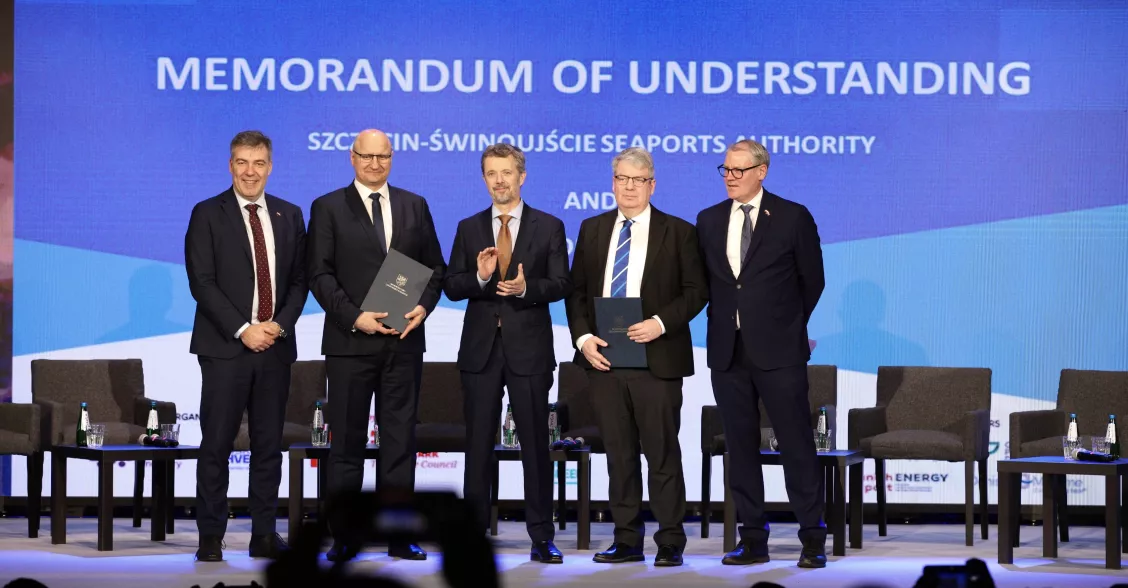In a move to expand their collaboration eastward, Europe’s largest offshore wind ports have welcomed Poland’s Port Szczecin to the Offshore Wind Port Alliance. The alliance aims to optimise the deployment of offshore wind in order to achieve Europe’s very ambitious targets.
Offshore wind farms are an essential part of the green transition, but port capacity is in short supply, and that may present a challenge in terms of meeting the ambitions for the green agenda.
However, the group of key ports for offshore wind in northern Europe now welcomes a new partner, the Polish Port Szczecin, to the Offshore Wind Port Alliance, increasing its group of members from six to seven. Through close cooperation, the members of the alliance expect to provide additional capacity for building wind farms, because the ports can optimise their processes and coordinate the logistics value chain.
The agreement for the Polish port to join the alliance follows a close dialogue and negotiations and was signed earlier today. The event coincides with a Danish business delegation headed by His Majesty King Frederik X visiting Poland.
A perfect fit for the Offshore Wind Port Alliance
“Our goal is to optimise the deployment of offshore wind, and we are very pleased to welcome Port Szczecin as a member of our alliance. Szczecin is a forward-looking port where Vestas currently is building factory facilities. The port is developing an area for offshore wind and has high ambitions for wind in general. That makes them a perfect fit for the Offshore Wind Port Alliance,” says Dennis Jul Pedersen, CEO of Port Esbjerg, speaking on behalf of the Offshore Wind Port Alliance.
The offshore wind market is growing strongly in the Baltic region and the first large-scale wind farms are currently being erected in Poland. Poland has plans to generate 74 percent of its power from renewables and nuclear by 2040 which is a significant upscale from Poland’s previous energy strategi.
The Esbjerg Declaration dramatically increased the target for offshore wind in Europe. That target was further driven through the so-called Ostend Declaration, which is backed by a coalition of nine countries committed to develop the North Sea as a green powerhouse for Europe. At The Marienborg Declaration from the Baltic Sea Energy Security Summit, it was decided to establish wind in the Baltic Sea region of at least 19.6 GW by 2030, seven times the current capacity.
The agreements express an ambition to establish 120 GW offshore renewable energy in Europe by 2030 and 300 GW by 2050.
Germany, Denmark, Belgium, and the Netherlands have set a common target to deliver at least 65 GW of offshore wind by 2030. That will put pressure on ports. To support the target, Europe’s largest wind ports joined forces in the Offshore Wind Port Alliance a year ago aiming to optimise and work together to meet the high ambitions. With Port Szczecin among its members, the alliance now also has a port that can serve the Baltic countries.
”We are very proud to have been invited to join this alliance, which we believe can help accelerate the work being done to promote offshore wind all over Europe. With this move, we are becoming a part of the future,” says Krzysztof Urbaś, CEO of Seaports Authority Szczecin-Świnoujście.
The other ports of the alliance are Port Oostende in Belgium, Groningen Seaports/Eemshaven in the Netherlands, Niedersachsen Ports/Cuxhaven in Germany, Nantes-Saint Nazaire Port in France, Humber in the UK, and Port Esbjerg in Denmark.
The current geopolitical situation in Europe and the ongoing green transition requires that more turbines are installed - preferably quickly to help build a security regarding Europe’s energy supply. That is why the ports are strengthening the collaboration at the operational and practical level.
Ports sharing insights and knowledge
Specifically, the collaboration between the seven ports consists of ongoing coordination and knowledge sharing, which enables them to optimise capacity utilisation between the ports to build wind farms more efficiently. Wind turbines require a lot of space at the ports, so lack of space is a specific challenge the ports are working to solve together. If one port only has space for half a project, another port may have space for the other half. In this way, the offshore wind farm can be built as scheduled and the client will not have to wait for space at one specific port.
The ports have held several joint workshops and have worked on, among other things, digital solutions to optimise capacity at the ports, and will soon launch a communication platform for sharing knowledge and experience.
“By working together, we can all make a powerful contribution toward achieving the European targets,” says Krzysztof Urbaś, CEO of Seaports Authority Szczecin-Świnoujście.
Go to overview

